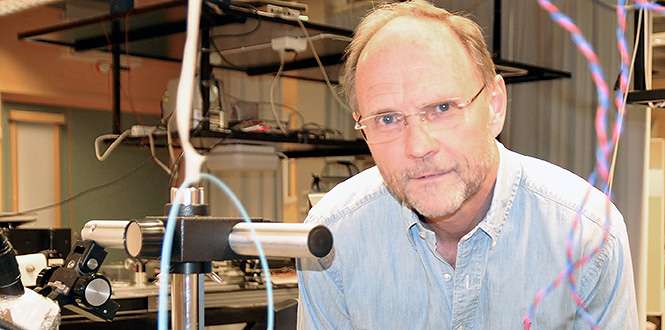Paving the way for fast low-energy data communications

Fibre-optic cables are revolutionising data communication worldwide. Within three years, Chalmers researchers expect to be able to transfer 100 Gb of data per second in a single fibre with one core, and several terabits per second in a cable with multiple fibres and cores.
"The world's data communication is increasing exponentially. Transmission speeds are so high already that wire cables are increasingly being replaced with optical fibre. Our project is about developing the technology that can equip these cables with even higher capacity," says Anders Larsson, professor at the Department of Microtechnology and Nanoscience – MC2 – at Chalmers University of Technology.
Boosting speed in the cables
In practice, this means boosting speed in the cables. The requirements here are completely different than those in regular telecommunications. Data communication requires simple, cheap, low-energy solutions. The focus is on developing the laser on the transmitter side of the cable, which converts electronic signals to optical ones.
"We're trying to make the laser increasingly faster while consuming less and less energy. The fact is that we already make the world's fastest, most energy efficient lasers – a result of 20 years of dedicated research in the field. What's new is that we've also started looking at the electronics side, both the transmitter and receiver on the optical fibre," Larsson says.
Co-optimisation
A third part of the project is to try to find more advanced ways of transferring the actual data.
"We want to code the data into the optical signal to transfer even more bits per second, using the speed the system already provides. To do this, we must work with the lasers, the electronics that drive the lasers and receive the signal at the far end, and also with modulation formats and coding to fit even more data into a given bandwidth on the system. The great challenge then is to co-optimise the electronics, optics and algorithms.
The five-year project is funded by the Swedish Foundation for Strategic Research (SSF) and has already come a long way. They've currently reached speeds of 70 Gb per second in a single-core cable and 240 Gb per second in a six-core cable.
"Within three years, we'll be able to transmit several terabits of data per second. In terms of power consumption, our goal is to reduce it to one tenth of today's level. We aim to set a new world record in terms of transmission capacity and energy efficiency," Larsson says.
Provided by Chalmers University of Technology

















